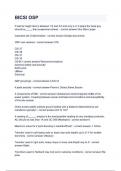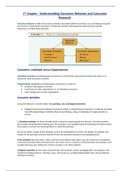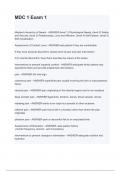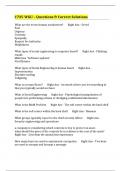TOPIC 1: VECTORS
1.1 Definition of a vector
A scalar quantity is specified by its magnitude without direction e.g. distance,
speed, mass etc.
A vector quantity is completely specified by its magnitude and the direction of
its action e.g. displacement, velocity, force etc.
Vectors are always represented by a straight line with an arrow showing the
direction
B
A
Figure 1.1
Its origin/ tail is at A and its end/tip is at B.
1.2 Properties of a Vector
i). Equality of two vectors
Two vectors A and B are equal if and only if they are equal in magnitude
and point in the same direction. i.e. if and point
in the same direction.
Figure 1.2
Equal vectors i.e. same magnitudes and pointing in same direction
Figure 1.3
Unequal vectors i.e. same magnitudes pointing in different directions
Figure 1.4
17
, Unequal vectors i.e. different magnitudes pointing in the same direction.
ii). Adding / subtracting vectors
When two vectors are added or subtracted from each other the result is
also a vector. Given vector A added to vector B and the resultant vector is
vector C, then we link the tip of vector A to the tail of vector B. The
resultant vector C has its tail/origin at the tail of vector A and its tip at the
tip of vector B; as shown in the diagram below.
A B
C
Figure 1.5
A geometric construction can be used to add more than two vectors
Vector addition is
a) Commutative i.e. A + B = B + A
b) Associative i.e. A + (B + C) = (A + B) + C
The above two laws obeyed by vector addition imply that the magnitude
on the left hand side of the equation is equal to the magnitude on the right
hand side of the equation.
iii). Negative of a vector (subtraction)
The negative of a vector A is defined as the vector which when added to
vector A gives zero if a vector sum is performed.
i.e. A + (- A) = 0
Vectors A and –A have the same magnitude but points in opposite
directions.
Subtraction is adding a negative of a given vector to another vector.
iv). Magnitude of a vector
Given a resultant vector C such that C = A + B, the magnitude of vector C
is computed as follows
But if A is parallel to B and in the same direction, then
Example
A car travels 20km due north and then 35km in the direction of 60 0 west
of north. Find the magnitude and direction of the cars resultant
displacement.
Solution
We need to draw the sketch showing the cars displacement
18
, Figure 1.6
Applying cosine rule , thus
To find direction apply the sine rule
; ;
;
Therefore, the resultant displacement of the car is 48.22km in a direction
38.950 west of north.
v). Multiplying a vector by a scalar
If a vector A is multiplied by a scalar m, the product mA is a vector that has
the same direction as vector A and magnitude mA. If the scalar is m,
then the product mA is a vector directed opposite vector A but of
magnitude mA.
vi). Components of a vector
Consider vector A in the figure 2.7 below.
Figure 1.7
19
, A vector A lying in x-y plane can be represented by Ax and Ay
Note
The sign of components Ax and Ay depends on the angle . E.g. if is
1200 then Ax is negative and Ay is positive. This is the idea of quadrants.
Figure 1.8
When solving problems, you can specify a vector A, either with its
components Ax and Ay or with its magnitude and direction A and .
vii). Unit vectors
Vector quantities are often expressed in terms of unit vectors. A unit
vector is a dimensionless vector having a magnitude of exactly one unit.
We shall use the symbols , and to represent unit vectors pointing in
the positive x, y and z-directions respectively. (The hats on the symbols
are standard notation for unit vectors).
Note
- Unit vector in the positive x-axis
- Unit vector in the positive y-axis
- Unit vector in the positive z-axis
, and forms a set of mutually perpendicular vectors in a right-handed
coordinate system as shown in the figure below
20







